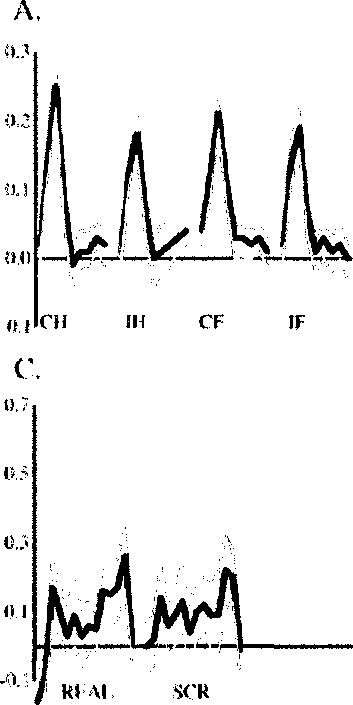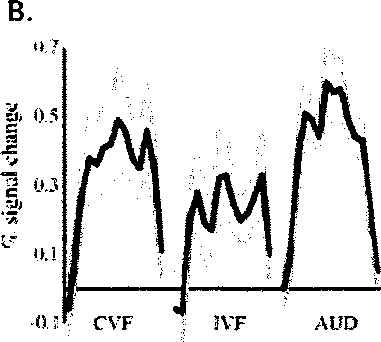60


Figure 4. Time course of average evoked BOLD
response (n=8 subjects) in the STS multisensory area.
A. Response to contralateral hand (CH), ipsilateral
hand (IH), contralateral foot (CF), and ipsilateral foot
(IF) stimulation. Colored bars illustrate 2-second
stimulus duration. Black lines show mean, gray lines
show ±1SEM. B. Response to low-contrast moving
points in the contralateral (CVF) and ipsilateral (IVF)
visual field. Response to auditory stimuli (AUD) is
shown for comparison. Colored bars illustrate 20-
second stimulus duration (followed by fixation
baseline). C. Response to real (REAL) and scrambled
(SCR) photographs.
In macaque monkeys, area STP is located anterior and superior to areas MST and
MT. To determine the relationship between human MT, MST and STSms, previously
described techniques (Beauchamp, et al. 2007; Huk, et al. 2002) were used to create
maps of all three areas in two hemispheres (Fig. 5). MT was located in the posterior
bank of the ascending limb of the posterior inferior temporal sulcus. MST was located
anterior in the ascending limb of the sulcus, extending onto middle temporal gyrus.
STSms was located on the posterior bank and fundus of the STS, just anterior to MST.
Across subjects, a consistent anatomical landmark for STSms was the inflection point in
More intriguing information
1. The name is absent2. The name is absent
3. Update to a program for saving a model fit as a dataset
4. Outline of a new approach to the nature of mind
5. A Consistent Nonparametric Test for Causality in Quantile
6. Optimal Vehicle Size, Haulage Length, and the Structure of Transport Costs
7. The name is absent
8. Visual Artists Between Cultural Demand and Economic Subsistence. Empirical Findings From Berlin.
9. The effect of globalisation on industrial districts in Italy: evidence from the footwear sector
10. The name is absent